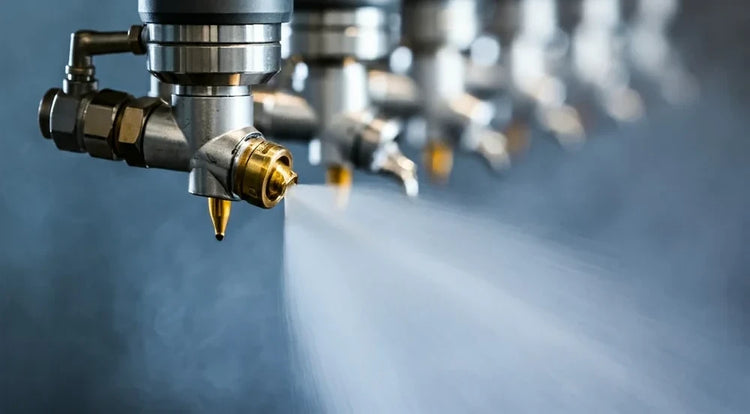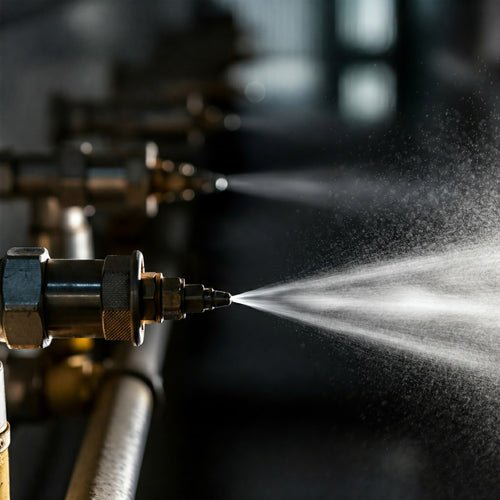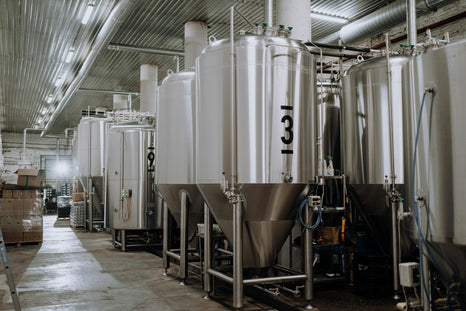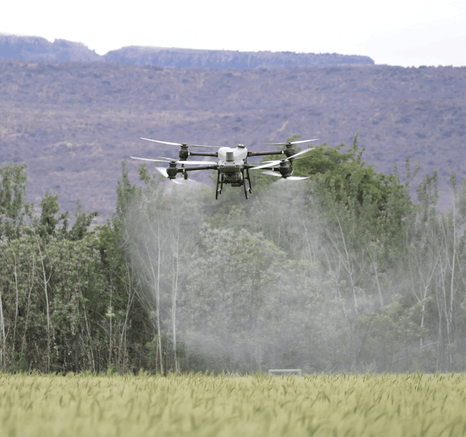Atomizing nozzles play a crucial part in many industries, turning liquids into fine sprays. These sprays are used in everything from painting cars to watering crops. Understanding how these nozzles work can help improve their performance and ensure they are used correctly.
Key Takeaways
- Atomizing nozzles break liquids into tiny droplets for various applications.
- Different types of nozzles use different methods for atomization, like direct spray and rotary atomization.
- Air atomizing nozzles use compressed air to create very fine sprays.
- The design of the nozzle and the pressure of the air and liquid affect the quality of the spray.
- Regular maintenance and proper operation are key to keeping nozzles working well.
The Atomization Process of Industrial Atomizing Nozzles
Industrial atomizing nozzles transform liquids into fine sprays through various mechanisms. These nozzles are essential in many industrial applications for tasks like dust removal, cooling, and moisture addition. The atomization process varies based on the nozzle's design and operational principles.
Direct Spray Nozzle Atomization
Direct spray nozzles work by forcing liquid through a small orifice at high pressure. This action breaks the liquid into tiny droplets, creating a fine mist. The nozzle's structure and the pressure applied play crucial roles in determining the spray's quality and consistency.
Rotary Atomizing Nozzle Atomization
Rotary atomizing nozzles use a spinning mechanism to disperse liquid. As the liquid hits the rotating surface, it is flung outward, breaking into fine particles. This method is effective for achieving uniform spray patterns and is often used in applications requiring precise coverage.
Pressure and Siphon Atomization
Pressure atomization relies on high-pressure liquid to create a spray, while siphon atomization uses a vacuum to draw liquid into the nozzle. Both methods are efficient but serve different purposes based on the required spray characteristics and application needs.
Mechanics Behind Air Atomizing Nozzles
Internal vs. External Mixing
Air atomizing nozzles can mix air and liquid either internally or externally. Internal mixing occurs within the nozzle, leading to finer droplets and more controlled spray patterns. In contrast, external mixing happens outside the nozzle, offering more flexibility in adjusting the spray.
Role of Compressed Air
Compressed air is crucial in air atomizing nozzles. It breaks the liquid into tiny droplets, creating a fine mist. The pressure and flow rate of the air can be adjusted to control the droplet size and spray pattern.
Impact and Friction Dynamics
The atomization process involves high-speed air impacting the liquid. This impact, combined with friction, breaks the liquid into small droplets. The speed and angle of the air stream play significant roles in determining the efficiency of atomization.
Understanding these mechanics is essential for optimizing nozzle performance and achieving desired spray characteristics.
Comparative Analysis of Air Atomizing Nozzles and Other Nozzles
Structural Differences
Air atomizing nozzles and other types of nozzles differ significantly in their construction. Air atomizing nozzles use compressed air to break up liquid into fine droplets, while other nozzles might rely on high pressure or mechanical means. This structural difference impacts their performance and suitability for various applications.
Performance Metrics
When comparing performance, air atomizing nozzles generally produce finer droplets and more uniform spray patterns. This makes them ideal for applications requiring precision. Other nozzles, such as hydraulic nozzles, might offer higher flow rates but less control over droplet size. Below is a comparison table highlighting key performance metrics:
|
Metric |
Air Atomizing Nozzles |
Hydraulic Nozzles |
|
Droplet Size |
Fine |
Coarse |
|
Spray Uniformity |
High |
Medium |
|
Flow Rate |
Moderate |
High |
|
Energy Consumption |
Moderate |
Low |
Application Scenarios
Air atomizing nozzles are commonly used in industries where precision and control are crucial, such as in coating and cooling processes. Other nozzles, like pressure nozzles, are often used in applications where high flow rates are needed, such as in firefighting or irrigation.
Understanding the specific needs of your application is essential for selecting the right type of nozzle. Each type has its own strengths and weaknesses, making them suitable for different tasks.
Applications of Air Atomizing Nozzles
Industrial Uses
Air atomizing nozzles are widely used in various industrial applications. They are essential for processes such as coating, gas cooling, and humidifying. These nozzles are also crucial in lubricating machinery and equipment, ensuring smooth operation and reducing wear and tear. Additionally, they play a significant role in pollution control by aiding in dust suppression and gas scrubbing.
Agricultural Applications
In agriculture, air atomizing nozzles are employed for spray irrigation, ensuring even distribution of water and nutrients to crops. They are also used for applying pesticides and fertilizers, which helps in maintaining crop health and increasing yield. The fine mist produced by these nozzles ensures that the chemicals are evenly spread, reducing waste and improving efficiency.
Environmental Control
Air atomizing nozzles are vital in environmental control applications. They are used in desulfurization towers to remove sulfur from emissions in power plants and chemical plants. These nozzles are also employed in fire suppression systems, providing a fine mist that can quickly extinguish fires. Furthermore, they are used in humidification systems to maintain optimal humidity levels in various settings, including residential, commercial, and industrial environments.
The versatility of air atomizing nozzles makes them indispensable in numerous fields, from industrial processes to environmental management. Their ability to produce fine droplets ensures efficient and effective application in various scenarios.
Factors Influencing Atomization Quality
Nozzle Design
The design of the nozzle plays a crucial role in determining the quality of atomization. A well-designed nozzle ensures uniform droplet size and consistent spray patterns. Key design elements include the orifice size, shape, and the internal flow passages. These factors collectively influence the breakup of the liquid stream into fine droplets.
Air Pressure and Flow Rate
Air pressure and flow rate are pivotal in achieving optimal atomization. Higher air pressure generally results in finer droplets, while the flow rate affects the spray angle and coverage area. Adjusting these parameters can help in tailoring the spray characteristics to meet specific application needs.
Liquid Properties
The properties of the liquid being atomized, such as viscosity and surface tension, significantly impact the atomization process. Liquids with higher viscosity require more energy to atomize, often necessitating higher air pressure or specialized nozzles. Conversely, liquids with lower surface tension tend to form finer droplets more easily.
Understanding these factors is essential for optimizing the performance of atomizing nozzles in various industrial applications.
Spray Patterns and Their Importance
Fan Spray Patterns
Fan spray patterns are commonly used in applications where a wide, flat spray is needed. These patterns are created by forcing the liquid through a narrow, elongated orifice, resulting in a spray that fans out. This type of spray is ideal for coating and cleaning applications because it covers a large area quickly and evenly.
Full Cone Spray Patterns
Full cone spray patterns produce a circular spray that covers the entire impact area. This pattern is achieved by using a spiral or vane inside the nozzle to break up the liquid into droplets. Full cone sprays are often used in cooling and washing applications where complete coverage is essential.
Symmetry and Uniformity
Symmetry and uniformity in spray patterns are crucial for achieving consistent results. A symmetrical spray pattern ensures that the liquid is evenly distributed, which is important for processes like coating and cooling. Uniformity in droplet size and distribution helps in achieving the desired effect without wasting material.
Ensuring the right spray pattern for your application can significantly improve efficiency and reduce costs. Proper selection and maintenance of nozzles are key to achieving optimal performance.
Optimizing the Performance of Atomizing Nozzles
Maintenance Practices
Regular maintenance is crucial for ensuring the longevity and efficiency of NozzlePro atomizing nozzles. Routine inspections can help identify wear and tear early, preventing costly downtime. Key maintenance practices include:
- Cleaning nozzles to remove any build-up of materials.
- Checking for clogs and blockages.
- Inspecting seals and gaskets for leaks.
- Replacing worn-out parts promptly.
Operational Guidelines
Following proper operational guidelines can significantly enhance the performance of atomizing nozzles. Operators should:
- Ensure the correct alignment of the nozzle to avoid uneven spray patterns.
- Adjust air pressure and flow rates according to the manufacturer's recommendations.
- Monitor the spray pattern regularly to detect any deviations.
- Use the appropriate nozzle type for the specific application.
Consistent adherence to operational guidelines can lead to optimal performance and extended nozzle life.
Troubleshooting Common Issues
Even with regular maintenance and proper operation, issues can still arise. Common problems and their solutions include:
- Uneven Spray Pattern: Check for blockages and clean the nozzle thoroughly.
- Reduced Atomization Quality: Verify air pressure and flow rates; adjust as needed.
- Leaks: Inspect seals and gaskets, replacing any that are damaged.
- Nozzle Wear: Regularly inspect and replace nozzles showing signs of wear.
By addressing these common issues promptly, NozzlePro customers can maintain high performance and efficiency in their atomizing nozzles.
Boosting the efficiency of atomizing nozzles can make a big difference in your operations. At NozzlePro, we specialize in providing top-notch nozzles that meet your specific needs. Whether you're looking for air atomizing or hydraulic atomizing nozzles, we've got you covered. Visit our website to explore our wide range of products and find the best nozzle for your application.
Conclusion
In conclusion, atomizing nozzles play a crucial role in various industrial applications by transforming liquids into fine sprays. Understanding their mechanics, such as the differences between air atomizing nozzles and other types, as well as the specific processes involved, is essential for optimizing their use. These nozzles are vital for achieving precise spray patterns and uniform droplet sizes, which are important for efficiency and effectiveness in many fields. By mastering the principles of atomization, industries can enhance their processes, leading to better performance and outcomes.












